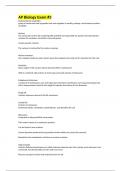Exam (elaborations)
AP Biology Exam #3
- Course
- Institution
AP Biology Exam #3 Endomembrane organelles group of membranes and organelles that work together to modify, package, and transport proteins and lipids Nucleus The central part of the cell containing DNA and RNA and responsible for growth and reproduction - contains the nucleolus, chromatin, ...
[Show more]



